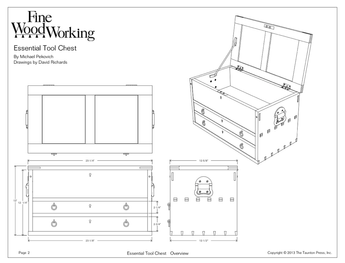I’m doing a little survey to find out what likes and dislikes of Gorilla Glue are, and what other glues might be used instead.please let me know what you all think! thanks!
Discussion Forum
Get It All!
UNLIMITED Membership is like taking a master class in woodworking for less than $10 a month.
Start Your Free TrialCategories
Discussion Forum
Digital Plans Library
Member exclusive! – Plans for everyone – from beginners to experts – right at your fingertips.
Highlights
-
Shape Your Skills
when you sign up for our emails
This site is protected by reCAPTCHA and the Google Privacy Policy and Terms of Service apply. -
 Shop Talk Live Podcast
Shop Talk Live Podcast -
 Our favorite articles and videos
Our favorite articles and videos -
E-Learning Courses from Fine Woodworking
-
-
 Fine Woodworking New England Event
Fine Woodworking New England Event -












Replies
I like it because it has a longer working time than yellow glue. It's completely waterproof. In a tight joint both polyurethane and yellow glue are stronger than the wood itself.
I don't like getting it on my fingers. Nothing takes it off.
The only downside I can think of is having to wear plastic gloves while working with it. It's almost impossible to get off your hands.
I use it exclusively for outdoor projects.
For me the jury is still out on polyurethane glue- I've had really inconsistent results with it on several projects. Currently working on a little project with Titebond III and so far I like it a lot better. No mad dog foaming, no joint failures so far, and much easier cleanup.
You don't like the mad dog foaming? That's my favorite part. I have actually had an easier time cleaning up the foam than yellow glue squeezout.
The only caveat with GG is that you have to be sure - very, very sure - that you want the parts you're sticking together with it to stay stuck together forever, because nothing breaks it down.
I've used it to repair a couple of "budget" guitars for friends, whose (the guitars') only hope for keeping the neck joint together was GG.
"...only hope for keeping the neck joint together was GG."
Chad,
Why do you say GG is the only hope? Are there reasons adhesives like epoxy or a plastic resin like Unibond wouldn't work? I'm curious to understand how you reached this conclusion.
Thanks,
-Jazzdogg-
Whether you think you can, or you think you can't, you're right.
"Chad,
Why do you say GG is the only hope? Are there reasons adhesives like epoxy or a plastic resin like Unibond wouldn't work? I'm curious to understand how you reached this conclusion."
Truthfully those other adhesives might work as well or better. I got as far as Gorilla Glue; it worked like a mad b**tard and insured my friends' cheapo guitars wouldn't be coming back to me for another repair for no money and not even any fun. (Danged plywood guitars, anyway...)
I like it for repairs but not for new work.
I have stopped using it because 1) the foam-out is too difficult to control and clean up, 2) I think other glues, such as Titbond II and III, are acceptably waterproof, and 3) the shelf life (at least with the Gorilla brand) is way too short.
Do not use it. There are other more suitable, and better glues out there.
It does not fill gaps, epoxy is much better.
Plastic resin glue has a better open time and is gap filling.
Yellow glues, waterproof and non water proof are easier to work with and more forgiving.
Won't buy the stuff again.
_________________________________
Michael in San Jose
"In all affairs it's a healthy thing now and then to hang a question mark on the things you have long taken for granted." Bertrand Russell
After MANY tries, I say "NAY". here is why:
1. If I need something that is going to be submerged...Epoxy is a better choice.
2. Titebond 3 seems to be an acceptable product.
3. Inconsistent results.
4. "Mad Dog" foaming.....I like that term!....dislike the foaming.
5. Far too much trouble for a product that is unproven to be superior.
On a better note, if I really feel the need for a polyurethane adhesive, I use PL Premium, the full bodied subfloor adhesive, not the GG knock off.
If I were gluing my hands together, it would probably be my second choice.
As far as Hand clean up: (Don't try this at home!)(OUCH)
1. Wire wheel.
2. Sulfuric Acid.
3. Belt sander
4. Sand blaster
5. Any fission reactor.
6. Matter/Anti matter reactor
7. Thermonuclear device.
John
John, sulfuric acid doesn't work. The skin and soft tissue disolve except where they are protected by the glue.
Wow, you may actually be sicker than I am! I feel bad for you!
John
GG is NOT waterproof like Titebond III. Don't try using it on an outdoor project - it will not hold up. May be the UV rays in combo with the rain / snow.
You are correct, it is the same stuff as Great Stuff and it will just not hold up to UV. It dries out, turns orange or brown and turns into dust. Worthless in the sunlight.
I love it, I used it on a set of six rocking chairs to laminate the rockers and it was wonderful, (they have been going strong for 5+ years). Also, I use it to laminate the ash platters I turn, it works great there too. There are quite a few people on this forum that hate it but I for one use it all the time. Just by in small quantities as the shelf life is not that long. As far as clean up, well if I wanted clean hands, I’d take up knitting and be over at the Threads forum, the foam scrapes off fine.
GG is way too expensive for what it's worth. Like others point out, there are many other excellent adhesives as strong or stronger that are more forgiving to work with.
I have to agree with Jackplane 100%. GG is is very expensive adhesive considering there are less expensive products out there that do as good as a job. And as others have noted-- the foaming is annoying. Although I have had good luck getting it off my hands with denatured alcohol.
Ounce for ounce-- I would use tightbond II... I think tightbond III is also a bit expensive and a little gummy to work with.
Good luck and happy gluing.
I was hopeful that polyurethane would be a great solution for woodworkers. I welcomed an easy to use waterproof glue that worked consistently and even had gap filling properties. My experience after several gallons and years has not been entirely positive.
The glue has not worked any better than most aliphatics in repairs of items like chair rungs, for example. I have had a couple of instances where I had to disassemble some wood to wood joints and found the glue to be brittle and the joint easily broken with a little shock. I cannot recall using it for non wood applications.
The shelf life is rather short. Some manufacturers containers, Franklin, have disintegrated. It is messy and difficult to clean up when still liquid. Very hard on clothes and fingers. The foaming action does not make it suitable for many applications. The gap filling qualities are weak since it is not much more than a brittle, crystalline foam.
The one thing that causes me concern is the vapors. The MSDS on the product states that, it can cause respiratory failure, allergic reactions, dermatitis as well as inflammation of the mucus membranes. I would be very cautious covering large panels indoors. Once a user is sensitized it may have some unpleasant health effects.
I still think it is a great glue for some applications but I would not use it for my all purpose shop glue.
How about this: If you drop and break a chunk out of an old cast-iron Stanley plane you can stick it back on with Gorilla Glue. It works like a charm.
Also, if you have an old Ford Truck and the foam in the arm rest turns into dust and the rest becomes hard an flat you can fix it with the stuff. Just take the rest off and find (or drill a hole in the bottom. Cover every square inch of the arm rest you do not want "foamed" with duct tape (it dissolves masking tape) then shoot some water in there (it is water cured) and then squirt "some" Gorilla Glue in there. Sit it down and run out of the building. Come back some days later and peal all the tape away...PRESTO! Now your arm rest is restored (it works with Geat Stuff too...but messier).
Used to use it a lot - don't anymore.
I went to PU glues because my shop was often cold and damp, so regular yellow glue takes a long time to dry. GG cures really fast in damp climates. But it is not as strong as yellow glue, and edge joints in oak would sometimes fail under shock loads. I discovered this when a customer returned a chair for repair; he had dropped it, and the back broke right along a glue line. I did some tests after that and found that I could often get a glue joint to fail by whacking it, and it would break right along the glue line - no wood involved - so don't believe the hype about the glue being stronger than the wood...
So, I've gone back to yellow glue for most things (woodstove makes it dry faster), and epoxy for certain things. Still use PU sometimes; I think it is probably better than yellow glue for M&T joints that don't fit snugly (yeah, I still screw those up sometimes) and it doesn't "creep" like yellow glue sometimes does. And for face-joining, where there is so much surface area that the glue strength is irrelevant, it's great because it cures so much faster.
"Everything should be made as simple as possible, but no simpler." A. Einstein
http://www.albionworks.net
I've used it some but as outlined above didn't really like it. I did however find a good use for it to glue PVC drain stems to wood for rod holders on my boat. Epoxy didn't work well but the GG held fast
I've used it to glue up some tops to end tables, the foam came off easily and no problems with finishing. (Tops were planed smooth after glue-up had dried.)
Immediately prior to application, I wiped both the jointed edges with a damp cloth, laid down a line of glue on one piece, spread it with a putty knife and clamped.
I use hide glue for all other joints, easier to repair.
YMMV.
Q: How do you know when a politician is lying?
A: His lips are moving.
Ignoring the times when I have tried a repair by "slap some glue on and see if it holds," the only woodworking joint I have had fail was with Gorilla glue. If the joint is good to begin with, ordinary yellow glue works fine. If the joint is imperfect, the gorilla glue expands to fill the area, but the expanded glue (foam) had virtually no strength.
Gorilla glue presumably works with material other than wood, so I tried it on some wood that had been finished (glue lacquer to lacquer), when pulling to see how strong the joint was, it broke along the glue line.
Gorilla glue has an amazingly short shelf life. I have thrown away far more than I have used.
I have used PL Premium Polyurethane construction adhesive when I needed slow setup time, waterproof glue, stick anything to anything, etc. It foams less, needs less clamping to keep the foam from pushing the joint apart, the foam appears to be much stronger (better gap filling), and costs FAR less than Gorilla glue. I have not been able to break apart previously finished or previously glued surfaces, although I have only tested "finished" projects, not pushed it to failure.
Did I mention that I don't like Gorilla glue?
________________________
Charlie Plesums Austin, Texas
http://www.plesums.com/wood
I like using poly's for veneering, minimal creep and an invisible glueline, but not for anything else. Too hard to clean out of crevices and other parts. I really like Titebond III for all general work, great glue and truly waterproof.
To all that want to read this..
I'm a professorial furniture builder and I have NOT had very good luck with the gorilla glue, I have built new and repaired with it , and the 4 chairs I built new all came apart in lass than 3 months after I delivered them . And the bar stools I repaired came back with loose joints, I cleaned all the old glue from the wood and bored the old holes so no glue was left in the old hole. I haven't found it any good for edge gluing. I have tried to contact the company to find out what and if I'm doing something wrong, and can not get any answer back. SO the bottle that I had left, I gave it to one of the members of our woodworking guild and let them try their luck. Sorry , but I would not consider their glue the strongest glue on earth.
I 'm going to stick with Franklin tite bond , Just as the furniture manufactures I've worked for use. I have used Tite bond for 20 years + and have NOT had any thing over the years come apart or get returned because of the glue.
Furniture BY Douglas Grand Rapids, Mich.
Poly for the right applications is great, but Pl and Excel are a lot cheaper than Gorilla.John O'Connell - JKO Handcrafted Woodworking
The more things change ...
We trained hard, but it seemed that every time we were beginning to form up into teams, we would be reorganized. I was to learn later in life that we tend to meet any new situation by reorganizing; and a wonderful method it can be for creating the illusion of progress while producing confusion, inefficiency, and demoralization.
Petronious Arbiter, 210 BC
This forum post is now archived. Commenting has been disabled